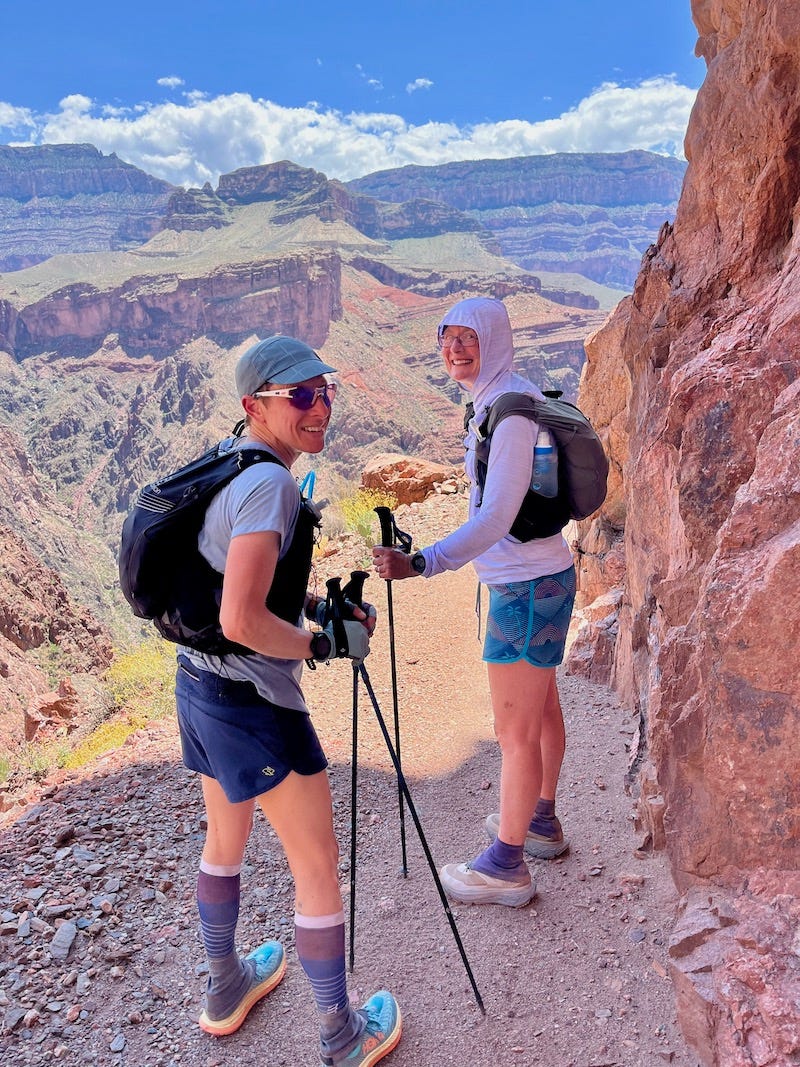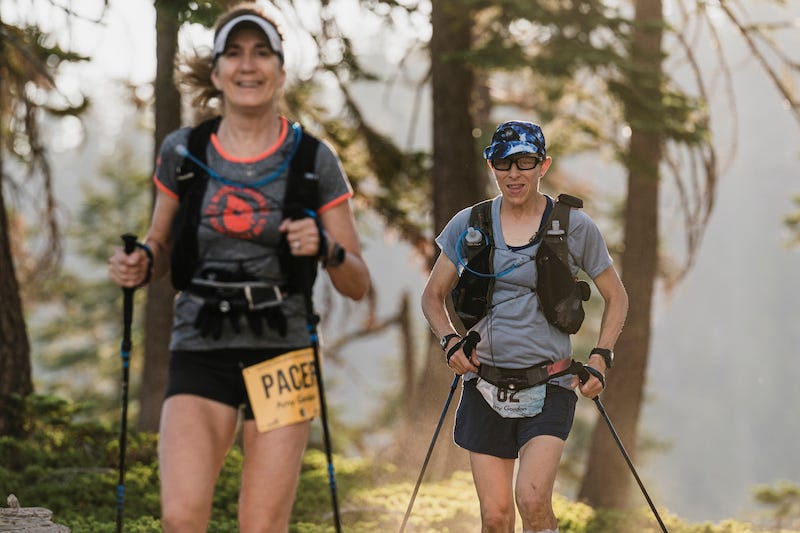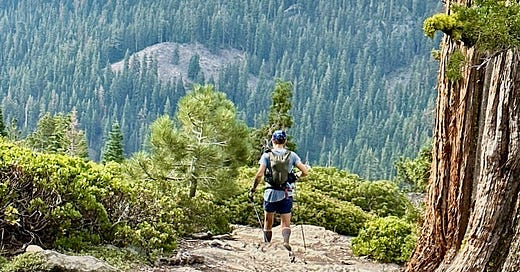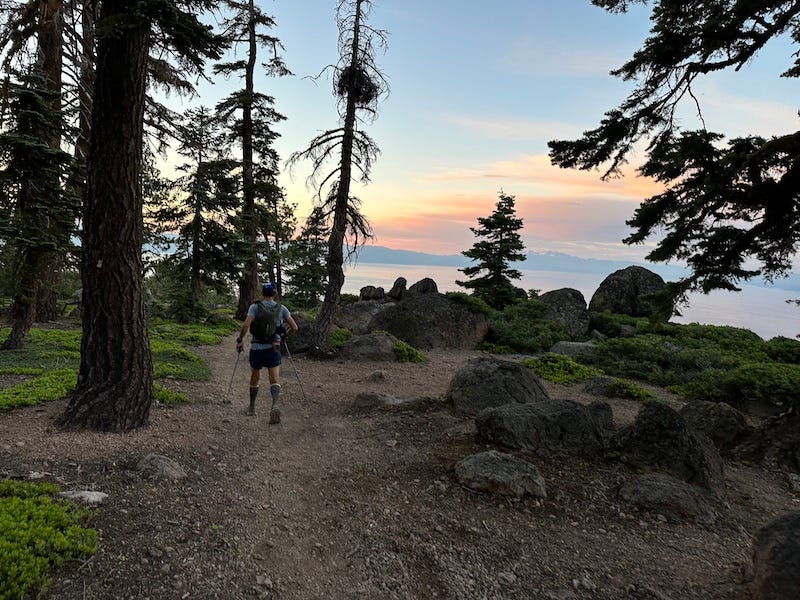How It Feels to Run a 200-Mile Ultra
A Q&A with Amy Gordon about her Tahoe 200 experience, hallucinations and all

Before I get to this week’s main story, I’d like to share two of the best things that happened this past week.
The heat wave broke, and belated monsoon rainstorms finally returned full force, if only for a few days. Like many, I followed the weather news with dismay at the abnormally (or new-normal) high temps throughout the Southwest. Where we live on a mountain-ringed mesa at 9000 feet elevation, the highs reached the high 80s and even touched 90. In past summers, a high of 82 was considered quite hot and the upper limit of “normal.” The tall verdant pasture grass—the greenest, healthiest grass I’ve seen here since about 2016, thanks to last winter’s snow—turned a straw-like yellow in a matter of days.
Imagine everyone’s relief last Sunday midday when the sky turned slate gray and released sheets of rain. It wasn’t the light sprinkling of moisture that teased and immediately evaporated in the preceding days. Big fat plops of raindrops pelted the windshield, requiring wipers turned to the highest level. Lightning split the sky, immediately followed by deafening thunderclaps. Torrents of rain created runoff and puddles, and our wheelbarrow (my inexact rain gauge) quickly filled a couple of inches. A measly fraction of an inch had been forecast, but the sky produced much more.
It happened again Monday and Tuesday, leaving behind clumps of hail. (Click through to watch this Instagram post from Monday afternoon, filmed on Telluride’s main street, with the sound on—the best video I’ve seen showing the downpours.)
Alas, a high-pressure ridge is rebuilding across the region, so who knows when these generous rains will return. I’m making note of these past three days of deluge to remind myself during the next heat wave that it can and should break.
Another uplifting thing that happened this past week: I went to the movies (for the first time in recent memory) to see Barbie and loved it! I didn’t know what to expect. Its humor, style, spot-on satire on gender relations, and music and choreography blew me away. 10 out of 10.
Now, let’s talk about mega ultras.
Going for days: What it’s really like to run a 200-miler
Preparing for September’s Run Rabbit Run 100, as detailed in last week’s post, makes me think long and hard about the challenge of steady running and hiking over some 30 to 36 hours. I’m bracing myself mentally for the discomfort and fatigue of running through the cold, dark night. I’m anticipating how those final 10 miles will feel when every step causes me to wince from a combination of achy knees, stiff lower back, and swollen and blistered feet.
The last phase of an ultra can feel utterly frustrating and bewildering because your ability to run with a full, smooth stride devolves into a hike-shuffle, as if your range of motion has been limited by a special rigor mortis for the half-dead. Energy and alertness abandoned you hours ago, so you stumble toward the finish in a stupor on autopilot.
At least, that describes my past three 100-milers, and I’m determined to train and troubleshoot in a way that enables me to finish this upcoming 100 with more energy and less discouragement.
My point is, that breakdown happens to me in the final phase of a mountain 100, usually in the middle of the night or close to daybreak, so about 20 to 24 hours into the 100-mile odyssey. The final six to 12 slow-motion hours in ultrarunning’s Purgatory seem interminable.
That’s 100 miles.
Now, imagine doubling the distance and tripling the time. That’s a 200-miler.
I’ve been following the growth in popularity of 200s over the past several years and crewed a friend at one. And still, I struggle to get my head around it or desire to do it, except out of curiosity. I can’t fathom how it would feel to extend the final-phase struggle of a 100-miler over another two to three days, with only brief naps to combat sleepiness.
For this reason, I engaged in the following conversation with my friend Amy Gordon, who’s a member of this subscriber group, because she succeeded in finishing the July 21 Tahoe 200 with a strong performance. Amy finished 30th overall out of 113 finishers, and 6th female, with a time of 84 hours (that’s 3 days + 12 hours) and 42 minutes. For comparison, the overall winner, Clare Bannworth, took 62 hours, 24 minutes. The final finishers took over 103 hours (that’s 4 days + 7 hours!). The event has a 105-hour cutoff.
I wanted to know: What’s it really like? What’s the appeal of 200s vs. 100s? How do you feel during and after?
The Tahoe 200 is one of three put on by Destination Trail Races, the other being the Bigfoot 200 in Washington State and Moab 240 in Utah. Other popular 200s include the Cocodona 250 across Arizona and the venerable Tors des Geants in the Italian Alps.
Amy, age 46, and I met several years ago through our mutual friend Clare Abram, and she’ll be my main pacer at Run Rabbit Run next month. Ever since I met Amy, I’ve been impressed and intrigued by her eclectic background—she worked as an attorney in the U.S. Army, then became a professional acupuncturist in Flagstaff, then moved to Fort Collins to pursue an MFA degree at Colorado State University. She started running ultras in 2014 and has finished nine 100-milers plus last year’s Cocodona 250, in addition to last month’s Tahoe 200.
What follows is our Q&A from last Friday via Zoom, edited for length and clarity.

Me: Congratulations! How are you feeling now?
Amy: The main thing I feel right now is sleep deprived, just exhausted. I got home an hour ago and barely took anything out of my van. I'm like, that's for tomorrow! That race was definitely the hardest race I've ever done—harder than Cocodona, for a variety of reasons. So I'm satisfied. During it, there were times when I was wondering what the hell I was doing out there. But because it was so hard, I think it's even more satisfying than most races.
What made it harder than Cocodona [which is approximately 256 miles], and also, what did the total mileage of the Tahoe “200” end up being?
That’s part of what made it hard—the mileage was supposed to be 206, but we think it was around 214. And from the start, every aid station was farther than we were told it was going to be. So psychologically, that made it hard. But mainly, the heat—the first two days were incredibly hot, especially the second afternoon. The section I was on [around Mile 100] was mostly exposed, and you're up pretty high, and it was just baking sun with zero breeze whatsoever. That was brutal. All that kept going through my head was, how can I do two more afternoons like this?
I don’t know if anyone actually knew the temperature. [Weather reports show it reached the high 80s in towns around the lake, so likely the sun felt stronger and hotter in the mountains’ high altitude.] When I got to the aid station after that section, I started sobbing, and I wasn't the only one—everyone at that aid station was a wreck.
I also think it was harder because I pushed myself a little bit harder at Tahoe and slept less. At Cocodona, I was very cautious since it was my first 200, and I didn't know if I would just implode all together. Here, I did push myself a bit more with less sleep. And I had fewer pacers here, so for two nights I was alone.
What was appealing about doing the Tahoe 200? Why did you sign up for this, and what were your goals going into it?
I signed up for Cocodona [in 2022] sort of on a whim, because it was so close to me [while living in Flagstaff], and I thought, if I'm ever going to do 200, it might as well be one where I know the trails and have easy access. And then after Cocodona, I wanted to see if I could improve on some things that I did there.
I chose Tahoe because I love the trails there. I knew it would be beautiful, which is always helpful, and honestly, it fit my schedule. So really it was that I wanted to see if I could do things a little bit differently than at Cocodona.
What do you think you improved?
I think I was much better at aid stations at being efficient, and staying when I needed to—whether it was to cool down or to get in food—but not wasting time. It's easy in a 200, when you have, like, all the time in the world, to dally and just talk to your crew or start talking to other runners. I tried to be much more efficient but still take care of what I needed to. I also slept less, which was a big goal, to see how I would do on less sleep. I did hallucinate a whole lot more [laughs]. I never ran hard, but I definitely was willing to push a little bit harder throughout, because I knew based on Cocodona that I could do it.
How much and when did you sleep?
I came into Heavenly [one of the aid stations with a sleep area for runners, around Mile 62 on the first night] around 3 or 3:30 a.m. and slept for an hour and a half. I had horrid nausea coming into it, so I hadn't eaten a ton, which is par for the course for me. So I tried to eat a little something, slept, then woke up and felt great and ate a whole bunch more. So I slept for about 90 minutes then.
Then I slept next at around Mile 115ish, around 12:30 a.m. [the second night]. I slept for two hours. When I woke up, my legs definitely felt stiff, but I felt better, like I knew that the rest had been good for me. I think part of the benefit of sleep is you can get more food in, if you eat something before you go to sleep and then after you wake up.
Then, Kim started pacing me, which was amazing. She was with me from around miles 115 to 135. We started at 3:30 on the third morning, and she was a lifesaver—and I felt incredible. We talked the whole time. We were keeping the pace super easy, but it was one of my faster sections. It was wonderful and a gorgeous morning.

Then I said goodbye to Kim, and that's where you do this 8-mile out-and-back, and I felt great. I was actually jogging uphill. I'm like, where did that come from?
But by the third afternoon, my legs were really heavy and tired, and I remember thinking to myself, man, did you overdo it? Like, what is up with your legs? Were you having too much fun with Kim and pushing it? But then I was like, oh my God, I've been out here for over 135 miles, of course my legs are tired!
On this climb, everyone was moving slowly. I was leapfrogging with two other guys, and it was hot. We all stopped at the lake to refill water and cool off. Then I got back to where I'd slept the second night [Brockway Summit aid station, around Mile 157] and slept again.
My crew Carol, who's amazing, was there. I had been planning to sleep for like three hours, and Carol said, “You're good with an hour and a half.” So I was like, all right. [laughs] I slept for an hour and a half, then woke up and went back out around midnight [of the third night]. It was only a 14-mile section after that, but it's just an absurd descent through brush and scree. It was horrendous.
Then, on the road back to the aid station, I was sleepwalking—like, my eyes were closing. I was hallucinating big time. I can't even remember what I saw when. But I know at one point I thought there were big white curtains hanging in the trees, and I’d look really closely and see nothing, but then I'd start running again and see it in my peripheral vision and be like, I'm going to catch that curtain.
Also on the road back to that aid station, when it was around 3 in the morning, I kept thinking, there's a biker coming up behind me, and I’d jump out of the way and turn around, but there was nothing there.
Then I got back to the aid station around Mile 170 and was like, “Carol, I need another hour of sleep, because I will be out of my mind if I don't,” so I slept maybe 45 minutes.
Tell me about how you were able to eat during all this time, because I know you have challenges nutritionally due to celiac disease.
At first I was really good about getting something in every half hour, and then I would go through bouts of nausea and be like, OK, just every hour get something in. And I tried to be really good about eating before I slept and when I woke up.
But when I left the aid station for that last 40 miles, I couldn't keep anything down, and that was a disaster and miserable.
Were you puking?
No, other end. Diarrhea. I would put something in my mouth and feel my stomach churn. I got to that last aid station and told the medic, and she said, “We've been seeing this a lot. We think the heat just really took a toll on people and is showing up in different ways.” So I laid down there for 20 minutes, took an Imodium that I had in my drop bag, and tried to get in some mashed potatoes. I had about 19 miles to go. Then the Imodium kicked in, and I was able to eat and start jogging. So that last section was good.
Besides the mythical bikers riding up behind you, did anything else crazy happen?
I hallucinated a lion, mane and all, just sitting on the side of a tree. Maybe I was hopeful it would eat me, because that's when I was feeling horrible. And when we were running up single track above Heavenly, I thought I was running through a junkyard. It was just wild.
Did you ever flirt with dropping, and if so, what made you push through?
No. On that second afternoon when I felt miserable, I didn't even flirt with dropping. I remember consoling myself by telling myself, Well, you could drop. But it wasn't that I saw it as an actual option. It was more just a way of reminding myself that you're choosing to do this. You don't have to. And in some weird way, that made me feel better.
What did your coach, Ian Torrence, do to prepare you that you think was the most valuable?
Lots of long back-to-backs or three-days. He calls them run-hikes, and often he'd have me do, like, a Friday night for 3 hours after dark, then something like 8 hours Saturday, 8 hours Sunday. And what he had me doing from the beginning was run-hike, so on flats or slight ups, I’d run 10 minutes, walk 1 minute. I’d hike anything 6 percent or more, and even on downhills, I’d take a walk break every 10 or so minutes. Doing that in training, and from the start of the race, helped me have as much energy as I could at the end.
And it cultivates patience.
It does! Getting used to doing that in training, it came naturally, and I didn’t feel guilty about not running uphills, because I was used to it, and I knew it’d pay off in the end. And I always started super conservatively, and always did the long training runs with my pack full with all my Tahoe stuff.
Talk about the pros and cons of 100s versus 200s, because I'm still not interested in spending three-and-a-half to four days with short bits of sleep; I'd rather do a 100 steadily and well.
I like both of them! I think I'll probably do a 100 next. Last summer I did both—I did Cocodona [in early May] and then Cascade Crest 100 [in late July]. I've been trying to put my finger on the exact differences. Sleep is a huge one, obviously, and it's not just the lack of sleep, but the strategy around sleep, that adds an element. Part of it is like, I'm not ever going to be super fast at a 100, so I guess I might as well try 200.
But a 200 does take you to a different level even than 100, and it might be less the running than the sleep and calorie deprivation. I felt like I ate so much—like I was eating a ton—but you're still depleted; you eat, and it's immediately burned for energy.
After two days [in a 200], it's just a different level of fatigue and depletion, and it's not that I enjoy it, but I guess it’s different—a different type of challenge. But I still love the idea of doing a 100 as hard as I can and as well as I can. It’s not an either-or.
Bravo, Amy! I’m really proud of you, and thank you for sharing your story. I’m glad you seem upbeat about the experience. A lot of ultrarunners finish mega 200-mile ultras, like Tors des Geants, and seem to feel emotionally flatlined at the finish.
I did feel like that after Cocodona. This time, I’m satisfied I pushed through all those really tough stretches.
Thanks for reading! Please consider sharing this post on your social media or forwarding it to a friend. If others subscribe from your share, then you can earn a comp’ed paid subscription to receive bonus posts and an invitation to the monthly online discussion. This month’s meetup for paid subscribers will be Thursday, August 24, 5pm Mountain.






Go Amy!! Great interview. Really enjoyed hearing about the race, impressed by the sleep strategy and toughness through the heat. Happy it went so well (plus the bonus of some wild hallucinations!) :)
Thank you so much to Amy for sharing this! I don't know if I'll ever do over a 50-miler, but I love reading endurance athletes' stories, and I feel like we can all learn from their perseverance.